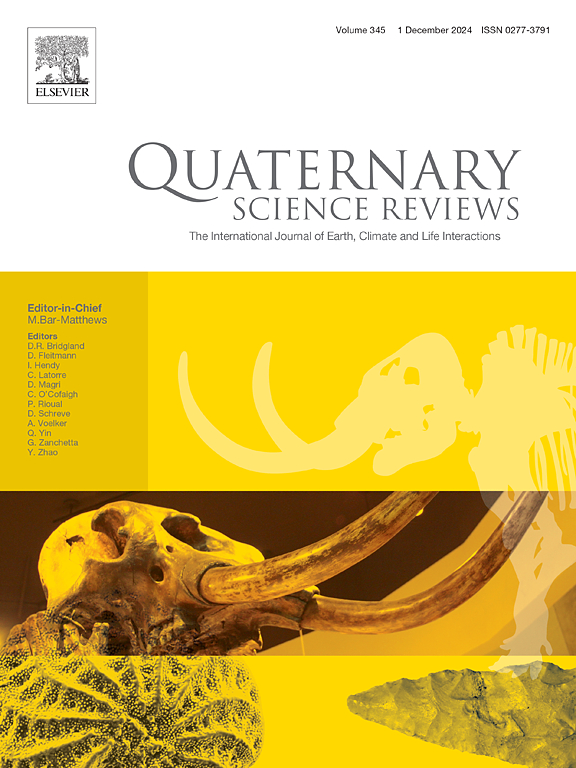在过去的3700年里,人类驱动的橄榄树在地中海中部的生态成功
IF 3.2
1区 地球科学
Q1 GEOGRAPHY, PHYSICAL
引用次数: 0
摘要
橄榄林是全球公认的地中海景观的象征,但其起源、生态和与不同文化的联系仍未得到充分了解,特别是在地中海中部和西部。为了填补这一空白,我们提供了自青铜时代早期中期(18世纪)以来东西西里岛(意大利)早期橄榄树开发的新见解。通过整合Pantano Grande(又名Lago di Ganzirri)湖泊沉积物的新型高分辨率孢粉学分析,古气候代用物以及来自历史和考古来源的社会文化变化描述,研究人员得出了这一结论。研究地点位于墨西拿海峡沿岸:自史前以来,海员从东地中海进入第勒尼安海的贸易和运输路线。植被的变化,包括橄榄树的繁殖和其他形式的土地利用或野生化,被发现与过去3700年来不断变化的社会文化模式是一致的。我们的研究结果表明,橄榄树的人为繁殖与三个文化阶段相吻合:(i)青铜时代早期-中期(Castelluccio和Thapsos文化);(ii)罗马时代;近代晚期(西西里王国)。这篇论文确立了一个比之前认识到的更早的日期,即意大利橄榄树开采驱动的景观转变的开始,这是地中海中部第二古老的证据。我们假设,在青铜时代早期中期,西西里岛和爱琴海之间的文化交流促进了墨西拿地区野生橄榄树的使用。在那个时候,橄榄树可以用于各种目的,包括水果生产,但也有木材和饲料的动物。橄榄园的发展在地中海中部经历了一个渐进的、多阶段的过程,直到近代才出现大规模的种植。尽管人类的影响导致了野生橄榄树种群的减少和局部灭绝,但它也确保了选定基因型的成功,使它们能够适应更广泛的环境条件。本文章由计算机程序翻译,如有差异,请以英文原文为准。
The human-driven ecological success of olive trees over the last 3700 years in the Central Mediterranean
The olive grove is a globally recognized symbol of the Mediterranean landscape, yet its origins, ecology, and linkage to different cultures remain inadequately understood, especially in the Central and Western Mediterranean. To fill this gap, we provide new insights into the early exploitation of olive trees in Eastern Sicily (Italy) since the Early-Middle Bronze Age (18th cen. BCE, 3700 BP), through the integration of novel high-resolution palynological analyses of lake sediments at Pantano Grande (a.k.a. Lago di Ganzirri), paleoclimate proxies, and descriptions of socio-cultural changes from historical and archaeological sources. The study site is located along the Messina Strait: a trade and transit route used by seafarers to enter the Tyrrhenian Sea from the Eastern Mediterranean since prehistory. Vegetation changes, including the propagation of olive trees and other forms of land-use or rewilding, are found to be coincident with changing socio-cultural patterns over the last 3700 years. Our results suggest anthropogenic propagation of olive trees coinciding with three cultural stages: (i) Early-Middle Bronze Age (Castelluccio and Thapsos cultures); (ii) Roman times; (iii) Late Modern times (Kingdom of Sicily). This paper establishes an earlier date than previously recognized for the beginning of landscape transformations driven by olive tree exploitation in Italy, representing the second oldest evidence in the Central Mediterranean. We hypothesize that cultural exchanges between Sicily and the Aegean in the Early-Middle Bronze Age have promoted the use of wild olive trees in the Messina area. At that time, olive trees could have been used for various purposes, including fruit production, but also wood and forage for animals. The development of olive groves followed a gradual, multi-stage process in the Central Mediterranean, with large-scale cultivation appearing only in modern times. Although human impacts have contributed to the decline and local extinction of wild olive tree populations, it has also ensured the success of selected genotypes, enabling their adaptation to a wider range of environmental conditions.
求助全文
通过发布文献求助,成功后即可免费获取论文全文。
去求助
来源期刊

Quaternary Science Reviews
地学-地球科学综合
CiteScore
7.50
自引率
15.00%
发文量
388
审稿时长
3 months
期刊介绍:
Quaternary Science Reviews caters for all aspects of Quaternary science, and includes, for example, geology, geomorphology, geography, archaeology, soil science, palaeobotany, palaeontology, palaeoclimatology and the full range of applicable dating methods. The dividing line between what constitutes the review paper and one which contains new original data is not easy to establish, so QSR also publishes papers with new data especially if these perform a review function. All the Quaternary sciences are changing rapidly and subject to re-evaluation as the pace of discovery quickens; thus the diverse but comprehensive role of Quaternary Science Reviews keeps readers abreast of the wider issues relating to new developments in the field.
 求助内容:
求助内容: 应助结果提醒方式:
应助结果提醒方式:


